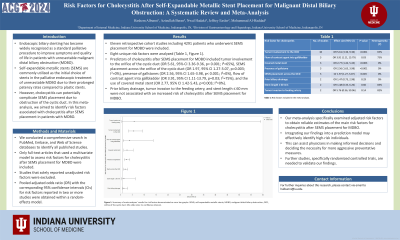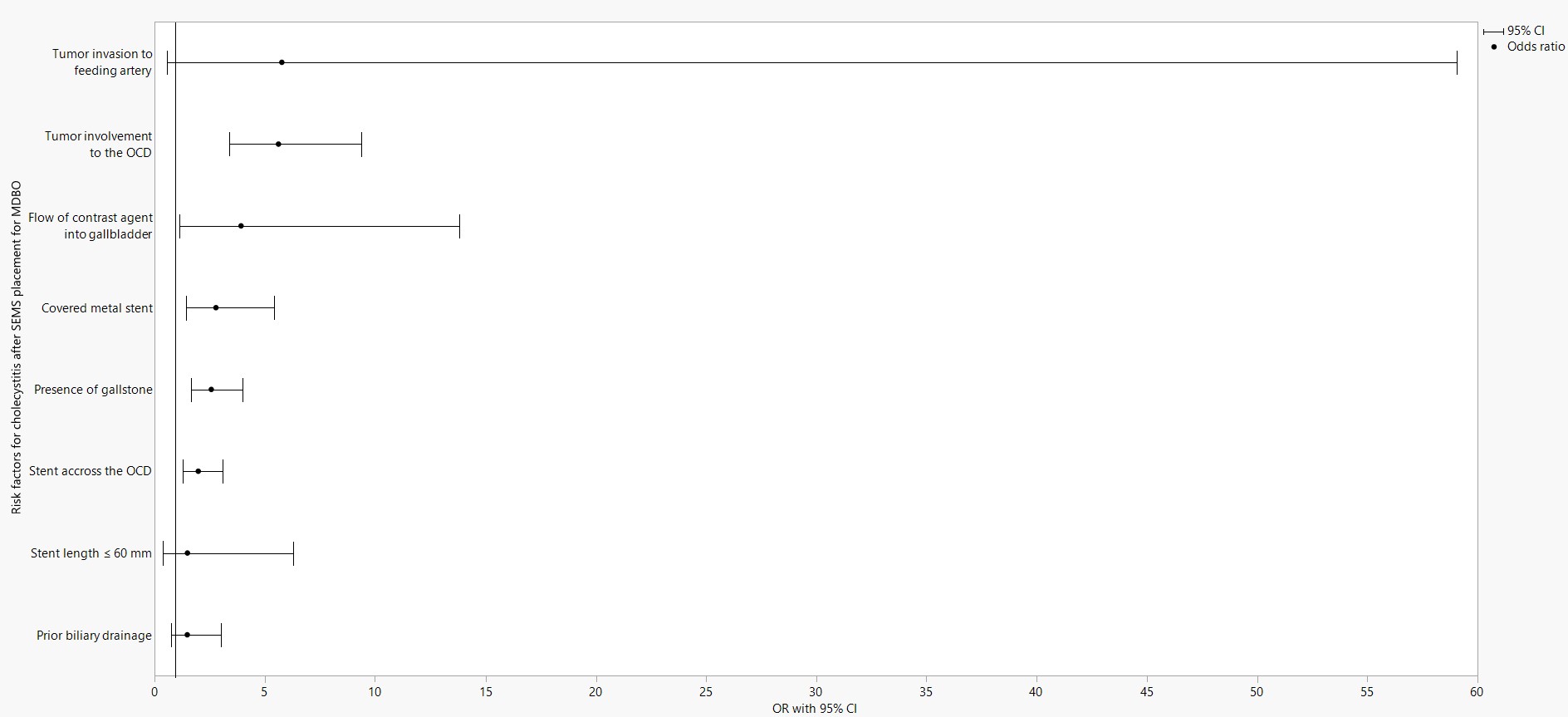Tuesday Poster Session
Category: Interventional Endoscopy
P4505 - Risk Factors for Cholecystitis After Self-Expandable Metallic Stent Placement for Malignant Distal Biliary Obstruction: A Systematic Review and Meta-Analysis
Tuesday, October 29, 2024
10:30 AM - 4:00 PM ET
Location: Exhibit Hall E

Has Audio
- HA
Hashem Albunni, MD
Indiana University School of Medicine
Indianapolis, IN
Presenting Author(s)
Hashem Albunni, MD, Azizullah Beran, MD, Nwal Hadaki, MD, Jeffrey Easler, MD, Mohammad Al-Haddad, MD, FACG
Indiana University School of Medicine, Indianapolis, IN
Introduction: Endoscopic biliary stenting has become widely recognized as a standard palliative procedure to improve symptoms and quality of life in patients with unresectable malignant distal biliary obstruction (MDBO). Self-expandable metallic stents (SEMS) are commonly utilized as the initial choice of stents in the palliative endoscopic treatment of unresectable MDBO due to their prolonged patency rates compared to plastic stents. However, cholecystitis can potentially complicate SEMS placement due to obstruction of the cystic duct. In this meta-analysis, we aimed to identify risk factors associated with cholecystitis after SEMS placement in patients with MDBO.
Methods: We conducted a comprehensive search in PubMed, Embase, and Web of Science databases to identify all published studies. Only full-text articles that used a multivariate model to assess risk factors for cholecystitis after SEMS placement for MDBO were included. Studies that solely reported unadjusted risk factors were excluded. Pooled adjusted odds ratio (OR) with the corresponding 95% confidence intervals (CIs) for risk factors reported in two or more studies were obtained within a random-effects model.
Results: Eleven retrospective cohort studies including 4291 patients who underwent SEMS placement for MDBO were included. Eight unique risk factors were analyzed (Table 1, Figure 1). Predictors of cholecystitis after SEMS placement for MDBO included tumor involvement to the orifice of the cystic duct (OR 5.61, 95% CI 3.36-9.36, p< 0.001; I²=65%), SEMS placement across the orifice of the cystic duct (OR 1.97, 95% CI 1.27-3.07, p=0.003; I²=0%), presence of gallstones (OR 2.56, 95% CI 1.65-3.98, p< 0.001; I²=0%), flow of contrast agent into gallbladder (OR 3.91, 95% CI 1.11-13.79, p=0.03; I²=75%), and the use of covered metal stent (OR 2.77, 95% CI 1.42-5.43, p=0.003; I²=0%). Prior biliary drainage, tumor invasion to the feeding artery, and stent length ≤ 60 mm were not associated with an increased risk of cholecystitis after SEMS placement for MDBO.
Discussion: Our meta-analysis specifically examined adjusted risk factors to obtain reliable estimates of the main risk factors for cholecystitis after SEMS placement for MDBO. Integrating our findings into a prediction model may effectively identify high-risk individuals. This can assist physicians in making informed decisions and deciding the necessity for more aggressive preventative measures. Further studies, specifically randomized controlled trials, are needed to validate our findings.

Note: The table for this abstract can be viewed in the ePoster Gallery section of the ACG 2024 ePoster Site or in The American Journal of Gastroenterology's abstract supplement issue, both of which will be available starting October 27, 2024.
Disclosures:
Hashem Albunni, MD, Azizullah Beran, MD, Nwal Hadaki, MD, Jeffrey Easler, MD, Mohammad Al-Haddad, MD, FACG. P4505 - Risk Factors for Cholecystitis After Self-Expandable Metallic Stent Placement for Malignant Distal Biliary Obstruction: A Systematic Review and Meta-Analysis, ACG 2024 Annual Scientific Meeting Abstracts. Philadelphia, PA: American College of Gastroenterology.
Indiana University School of Medicine, Indianapolis, IN
Introduction: Endoscopic biliary stenting has become widely recognized as a standard palliative procedure to improve symptoms and quality of life in patients with unresectable malignant distal biliary obstruction (MDBO). Self-expandable metallic stents (SEMS) are commonly utilized as the initial choice of stents in the palliative endoscopic treatment of unresectable MDBO due to their prolonged patency rates compared to plastic stents. However, cholecystitis can potentially complicate SEMS placement due to obstruction of the cystic duct. In this meta-analysis, we aimed to identify risk factors associated with cholecystitis after SEMS placement in patients with MDBO.
Methods: We conducted a comprehensive search in PubMed, Embase, and Web of Science databases to identify all published studies. Only full-text articles that used a multivariate model to assess risk factors for cholecystitis after SEMS placement for MDBO were included. Studies that solely reported unadjusted risk factors were excluded. Pooled adjusted odds ratio (OR) with the corresponding 95% confidence intervals (CIs) for risk factors reported in two or more studies were obtained within a random-effects model.
Results: Eleven retrospective cohort studies including 4291 patients who underwent SEMS placement for MDBO were included. Eight unique risk factors were analyzed (Table 1, Figure 1). Predictors of cholecystitis after SEMS placement for MDBO included tumor involvement to the orifice of the cystic duct (OR 5.61, 95% CI 3.36-9.36, p< 0.001; I²=65%), SEMS placement across the orifice of the cystic duct (OR 1.97, 95% CI 1.27-3.07, p=0.003; I²=0%), presence of gallstones (OR 2.56, 95% CI 1.65-3.98, p< 0.001; I²=0%), flow of contrast agent into gallbladder (OR 3.91, 95% CI 1.11-13.79, p=0.03; I²=75%), and the use of covered metal stent (OR 2.77, 95% CI 1.42-5.43, p=0.003; I²=0%). Prior biliary drainage, tumor invasion to the feeding artery, and stent length ≤ 60 mm were not associated with an increased risk of cholecystitis after SEMS placement for MDBO.
Discussion: Our meta-analysis specifically examined adjusted risk factors to obtain reliable estimates of the main risk factors for cholecystitis after SEMS placement for MDBO. Integrating our findings into a prediction model may effectively identify high-risk individuals. This can assist physicians in making informed decisions and deciding the necessity for more aggressive preventative measures. Further studies, specifically randomized controlled trials, are needed to validate our findings.

Figure: Figure 1. Summary of meta-analyses' results for risk factors demonstrated as error bar graphs.
SEMS, self-expandable metallic stents; MDBO, malignant distal biliary obstruction; OCD, orifice of the cystic duct; OR, odds ratio; CI, confidence interval.
SEMS, self-expandable metallic stents; MDBO, malignant distal biliary obstruction; OCD, orifice of the cystic duct; OR, odds ratio; CI, confidence interval.
Note: The table for this abstract can be viewed in the ePoster Gallery section of the ACG 2024 ePoster Site or in The American Journal of Gastroenterology's abstract supplement issue, both of which will be available starting October 27, 2024.
Disclosures:
Hashem Albunni indicated no relevant financial relationships.
Azizullah Beran indicated no relevant financial relationships.
Nwal Hadaki indicated no relevant financial relationships.
Jeffrey Easler: Boston Scientific – Consultant.
Mohammad Al-Haddad: Amplified Sciences – Grant/Research Support. Boston Scientific – Consultant. Interpace Diagnostics – Consultant.
Hashem Albunni, MD, Azizullah Beran, MD, Nwal Hadaki, MD, Jeffrey Easler, MD, Mohammad Al-Haddad, MD, FACG. P4505 - Risk Factors for Cholecystitis After Self-Expandable Metallic Stent Placement for Malignant Distal Biliary Obstruction: A Systematic Review and Meta-Analysis, ACG 2024 Annual Scientific Meeting Abstracts. Philadelphia, PA: American College of Gastroenterology.
